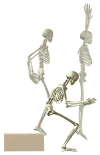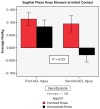Biomechanical measures during landing and postural stability predict second anterior cruciate ligament injury after anterior cruciate ligament reconstruction and return to sport
- PMID: 20702858
- PMCID: PMC4920967
- DOI: 10.1177/0363546510376053
Biomechanical measures during landing and postural stability predict second anterior cruciate ligament injury after anterior cruciate ligament reconstruction and return to sport
Abstract
Background: Athletes who return to sport participation after anterior cruciate ligament reconstruction (ACLR) have a higher risk of a second anterior cruciate ligament injury (either reinjury or contralateral injury) compared with non-anterior cruciate ligament-injured athletes.
Hypotheses: Prospective measures of neuromuscular control and postural stability after ACLR will predict relative increased risk for a second anterior cruciate ligament injury.
Study design: Cohort study (prognosis); Level of evidence, 2.
Methods: Fifty-six athletes underwent a prospective biomechanical screening after ACLR using 3-dimensional motion analysis during a drop vertical jump maneuver and postural stability assessment before return to pivoting and cutting sports. After the initial test session, each subject was followed for 12 months for occurrence of a second anterior cruciate ligament injury. Lower extremity joint kinematics, kinetics, and postural stability were assessed and analyzed. Analysis of variance and logistic regression were used to identify predictors of a second anterior cruciate ligament injury.
Results: Thirteen athletes suffered a subsequent second anterior cruciate ligament injury. Transverse plane hip kinetics and frontal plane knee kinematics during landing, sagittal plane knee moments at landing, and deficits in postural stability predicted a second injury in this population (C statistic = 0.94) with excellent sensitivity (0.92) and specificity (0.88). Specific predictive parameters included an increase in total frontal plane (valgus) movement, greater asymmetry in internal knee extensor moment at initial contact, and a deficit in single-leg postural stability of the involved limb, as measured by the Biodex stability system. Hip rotation moment independently predicted second anterior cruciate ligament injury (C = 0.81) with high sensitivity (0.77) and specificity (0.81).
Conclusion: Altered neuromuscular control of the hip and knee during a dynamic landing task and postural stability deficits after ACLR are predictors of a second anterior cruciate ligament injury after an athlete is released to return to sport.
Conflict of interest statement
One or more authors has declared a potential conflict of interest:
Figures








References
-
- Beard DJ, Dodd CA, Trundle HR, Simpson AH. Proprioception enhancement for anterior cruciate ligament deficiency: a prospective randomised trial of two physiotherapy regimes. J Bone Joint Surg Br. 1994;76(4):654–659. - PubMed
-
- Beard DJ, Kyberd PJ, Dodd CA, Simpson AH, O’Connor JJ. Proprioception in the knee. J Bone Joint Surg Br. 1994;76(6):992–993. - PubMed
-
- Bell AL, Pedersen DR, Brand RA. A comparison of the accuracy of several hip center location prediction methods. J Biomech. 1990;23(6):617–621. - PubMed
-
- Boden BP, Dean GS, Feagin JA, Jr, Garrett WE., Jr Mechanisms of anterior cruciate ligament injury. Orthopedics. 2000;23(6):573–578. - PubMed
-
- Boden BP, Torg JS, Knowles SB, Hewett TE. Video analysis of anterior cruciate ligament injury: abnormalities in hip and ankle kinematics. Am J Sports Med. 2009;37(2):252–259. - PubMed
Publication types
MeSH terms
Grants and funding
- R01 AR049735/AR/NIAMS NIH HHS/United States
- R01-AR055563/AR/NIAMS NIH HHS/United States
- R01 AR055563/AR/NIAMS NIH HHS/United States
- F32 AR055844/AR/NIAMS NIH HHS/United States
- F32 AR 055844/AR/NIAMS NIH HHS/United States
- UL1 TR001425/TR/NCATS NIH HHS/United States
- R01-AR049735/AR/NIAMS NIH HHS/United States
- R01 AR056259/AR/NIAMS NIH HHS/United States
- R01-AR056259/AR/NIAMS NIH HHS/United States
- UL1 TR000077/TR/NCATS NIH HHS/United States
- UL1 RR026314/RR/NCRR NIH HHS/United States
- UL1RR026314/RR/NCRR NIH HHS/United States
LinkOut - more resources
Full Text Sources
Other Literature Sources
Medical

